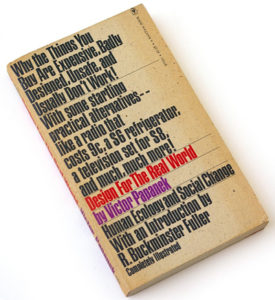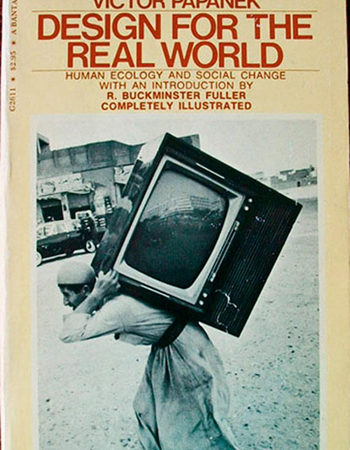Victor Papanek: pioneer of patronising design
Review of Papanek, Design for the real world: human ecology and social change, second edition, Thames & Hudson, 1985
Where has Victor Papanek been this past decade? When his first edition was published (New York: Pantheon Books, 1971), it quickly became a seminal tome in British art schools; today, still, it remains the key recommendation of many interior design lecturers. What is fascinating about this re-working is to see how much – and how little – the man’s highly influential views have changed.
The hubris of the new preface knows no bounds. It is true that by the design establishment wrongfully made Papanek a pariah when his theses first appeared. But while he has become part of the mainstream now, it is hard to believe that Real world has become a ‘required text in… English and industrial-management courses at many universities’. Again, the author confesses that his earlier remarks on design for the Third World were ‘patronising’, but now compounds his errors. Third World countries do not, he says, need fully automated factories: ‘You don’t hand a loaded gun to a baby’.
 The slightest acquaintance with the ‘real world’ of international trade today shows that this is wrong. The starving countries desperately need the kind of productivity that can allow them to exchange their goods on equal terms with the North. Otherwise they will remain at the mercy of the marauders of America, Japan and – Papanek’s omission of it strikes a characteristically left-wing trendy note – Western Europe.
The slightest acquaintance with the ‘real world’ of international trade today shows that this is wrong. The starving countries desperately need the kind of productivity that can allow them to exchange their goods on equal terms with the North. Otherwise they will remain at the mercy of the marauders of America, Japan and – Papanek’s omission of it strikes a characteristically left-wing trendy note – Western Europe.
Mr Papanek is just out of touch. While China is now desperate to put word processors in its offices and Western tourists in its hotels, the new preface upholds Mao’s 1956 programme for ‘decentralised solutions’ to technological and economic problems. We learn of the horrid IMF, but are told that ‘the last thirteen years has shown that autonomy and self-reliance are being realised in the Third World’. Tell that to the Brazilians! Where are their CAD-based space planning systems? Where are their alternatives to the shanty-towns of Sao Paolo?
It is admitted that ‘Drop City’, a commune of domes made of Colorado car-tops, is today marred by rust. But because they ‘fit in with the general socioeconomic order’, developments such as Drop City are good, while, with conventional US homes, the long-standing taste for early American furniture and the more recent boom in Japanese tatami wreak havoc.
 Yet Papanek believes there has been progress. ‘Design for the sick and the handicapped has become respectable now’, he argues, oblivious to the end of the British industrial designer’s affair with the hospital bed. Papanek is ‘delighted’ that his former critics have now ‘grown sleek on fat government and research grants’ (sic) by looking into his kind of issues.
Yet Papanek believes there has been progress. ‘Design for the sick and the handicapped has become respectable now’, he argues, oblivious to the end of the British industrial designer’s affair with the hospital bed. Papanek is ‘delighted’ that his former critics have now ‘grown sleek on fat government and research grants’ (sic) by looking into his kind of issues.
There are some good things in Real world. It is interesting to read that 100 people lost their lives when unsupported 100-foot skywalks in the Kansas City Hyatt-Regency hotel collapsed in 1981 – five days before the American Institute of Architects deigned to publish the first-ever study of skywalk safety (it recommended a maximum unsupported length of 45 feet). Pre-1977 colour tv sets, it is also revealed, are harmful when viewed at a distance of less than nine feet. Furthermore, there has been progress in fields such as the design of secretarial chairs: Papanek is right to mention Niels Diffrient’s pioneering works on ergonomics, and Sottsass’s recent range of seating for Knoll International. But overall the ‘new’ Design for the real world is older and more reactionary than ever.
As before, Papanek sneers at the irrelevance to design of writers such as Copernicus, Darwin, Marx and Freud. He still likes Bucky Fuller, Arthur Koestler, Christopher Lorenz and Desmond Morris, but now adds fresh thinkers in the shape of Ivan Illich (Tools for conviviality), Jonathan Schell (The fate of the earth) and, bizarrely, the racist Edward Wilson (Sociobiology). In his new preface, he blithely states ‘[Ernest] Schumacher agreed with my own formulation that nothing big works’.
At nearly 400 pages, the same can well be said of his new paperback.
Thread. What are the BBC playing at?
Articles grouped by Tag
Bookmarks
Innovators I like

Robert Furchgott – discovered that nitric oxide transmits signals within the human body

Barry Marshall – showed that the bacterium Helicobacter pylori is the cause of most peptic ulcers, reversing decades of medical doctrine holding that ulcers were caused by stress, spicy foods, and too much acid

N Joseph Woodland – co-inventor of the barcode

Jocelyn Bell Burnell – she discovered the first radio pulsars

John Tyndall – the man who worked out why the sky was blue

Rosalind Franklin co-discovered the structure of DNA, with Crick and Watson

Rosalyn Sussman Yallow – development of radioimmunoassay (RIA), a method of quantifying minute amounts of biological substances in the body

Jonas Salk – discovery and development of the first successful polio vaccine

John Waterlow – discovered that lack of body potassium causes altitude sickness. First experiment: on himself

Werner Forssmann – the first man to insert a catheter into a human heart: his own

Bruce Bayer – scientist with Kodak whose invention of a colour filter array enabled digital imaging sensors to capture colour

Yuri Gagarin – first man in space. My piece of fandom: http://www.spiked-online.com/newsite/article/10421

Sir Godfrey Hounsfield – inventor, with Robert Ledley, of the CAT scanner

Martin Cooper – inventor of the mobile phone

George Devol – 'father of robotics’ who helped to revolutionise carmaking

Thomas Tuohy – Windscale manager who doused the flames of the 1957 fire

Eugene Polley – TV remote controls



0 comments